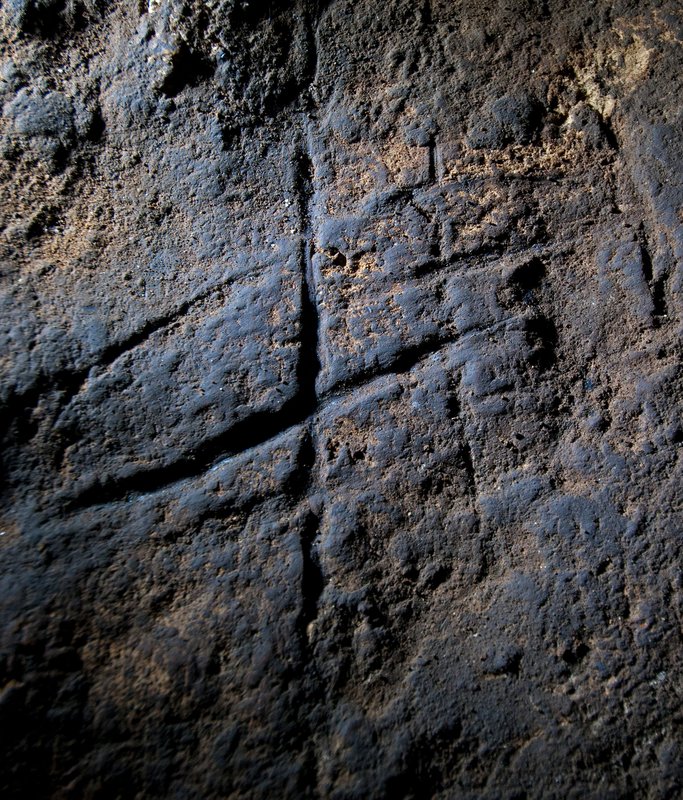
Scientists studying a curious rock engraving in the seaside Gorham’s Cave in Gibraltar are suggesting that its cross-hatched impression was created by Neanderthals and represents their capacity for abstract expression.
While excavating a layer of deposits dated within a range between 38,500 and 30,500 cal kyr BP (using radiocarbon dating), Ruth Blasco of the Gibraltar Museum and colleagues eventually came down to a layer pre-dating 39,000 BP consisting of bedrock that featured what appeared to be an intentional cross-hatch engraving. The engraving was found on a rock platform at an elevation of 40 cm above the cave floor and consisted of deeply engraved lines forming a criss-cross pattern.
“Here we present the first known example of an abstract pattern engraved by Neanderthals,” summarizes Blasco, et al., in their study report. “This discovery demonstrates the Neanderthals’ capacity for abstract thought and expression.”*
How they came to this determination stems from several different findings and considerations. First of all, excavation of undisturbed overlying sediments between 1997 and 2005 and then again in 2011 and 2012 yielded Mousterian stone artifacts, a type of stone tool technology typically associated with Neanderthals. They dated the finds using radiocarbon dating techniques to a time range later than 39,000 years BP. Geochemical analysis of the engravings also indicated that the engravings had to pre-date the overlying sediments. Moreover, microscopic and morphometric analysis of the engravings, as well as the making of experimental incisions using different stone tools and producing 3D reconstructions of the pattern and individual groove sections, indicated that the engravings were likely human-made. “The engraved pattern differs strikingly from the 1- to 4-cm–deep alteration cracks and other networks of natural fissures present on the exposed surfaces of the fine-grained lime-dolostone of the cave,” wrote the researchers in the report.*
_____________________________________________________
 Neanderthal rock engraving from Gorham’s Cave, Gibraltar. Image courtesy of Stuart Finlayson.
Neanderthal rock engraving from Gorham’s Cave, Gibraltar. Image courtesy of Stuart Finlayson.
_______________________________
The archaeological finds of Gorham’s Cave are controversially famous for their attribution to Neanderthals, suggested by some scientists to have inhabited the cave less than 40,000 years ago, a time by which many scholars think Neanderthals would have already become extinct, at least in present-day Western Europe. Gorham’s Cave has therefore become popularly albeit arguably known as the place where the “last Neanderthals” made their “last stand”, so to speak, before complete extinction. Now, with the discovery of what these researchers suggest to be symbolic engraving, these Neanderthals may have possessed a cognitive capacity that has long been exclusively attributed to modern humans, who are theorized to have arrived on the European scene around 40,000 years ago.
The suggestion that Nenderthals were capable of cave art, such as wall paintings and engravings, has long been debated, with other sites exhibiting possible signs of this cognitive capacity, such as El Castillo Cave in Spain, where painted dots dated to before 40,000 years BP point back to a possible Neanderthal authorship. The absence of associated archaeological remains at this site, however, has left room for doubt that the El Castillo paintings could be assigned to Neanderthals.
The detailed study report is published in the Proceeedings of the National Academy of Sciences.*
__________________________________________
*“A rock engraving made by Neanderthals in Gibraltar,” by Joaquín Rodríguez-Vidal et al.
Cover Photo, Top Left: Gorham’s Cave, photographed from Governor’s Beach, Gibraltar. Image courtesy of Clive Finlayson.
__________________________________________
Travel and learn with Far Horizons.
Read about the most fascinating discoveries with a premium subscription to Popular Archaeology Magazine. Find out what Popular Archaeology Magazine is all about. AND MORE:
On the go? Get the smartphone version of Popular Archaeology as an app or as an ebook.
Popular Archaeology’s annual Discovery Edition eBook is a selection of the best stories published in Popular Archaeology Magazine in past issues, with an emphasis on some of the most significant, groundbreaking, or fascinating discoveries in the fields of archaeology and paleoanthropology and related fields. At least some of the articles have been updated or revised specifically for the Discovery edition. We can confidently say that there is no other single issue of an archaeology-related magazine, paper print or online, that contains as much major feature article content as this one. The latest issue, volume 2, has just been released. Go to the Discovery edition page for more information.







